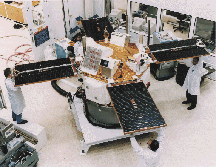Many science teams, such as the ACE project pictured here, are
repositioning satellites so they won't be damaged in the meteor
shower.
Click on image for full size
Image courtesy of NASA
Meteor Shower May Cause Problem with Spacecraft
News story originally written on November 15, 1998
The
Leonids meteor shower is expected to peak
on November 17th, 1998. The meteors may present a hazard to many
different satellites in orbit. This hazard could come in the form of
pierced skins or electronic disruptions due to impacts with meteors.
Even though most of the meteors are smaller than a grain of sand, they are
moving over 155,000 miles per hour. At that speed, the tiny meteors can
carry the same momentum as a .22 caliber bullet. A direct impact from a
speck-sized meteor could pierce the hull of a satellite. But, that is not
scientists' main concern.
The chances of an impact with a meteor large enough to pierce the hull are
very small. The real danger is caused by smaller, more numerous meteors
which won't damage the hull itself but may cause problems with electronics
inside the satellite.
The smaller meteors can vaporize on impact with spacecraft and create a
plume of ionized particles. These particles can create electric fields
in the satellites which might damage sensitive circuitry.
To try and minimize any damage, project members such as those for the
Advanced Composition Explorer may
power-down their satellites. They may also reorient their satellites to
either shield sensitive equipment or to present the smallest profile
toward the meteor stream.
You might also be interested in:

It was another exciting and frustrating year for the space science program. It seemed that every step forward led to one backwards. Either way, NASA led the way to a great century of discovery. Unfortunately,
...more
The Space Shuttle Discovery lifted off from Kennedy Space Center at 2:19 p.m. EST, October 29th. The sky was clear and the weather was great as Discovery took 8 1/2 minutes to reach orbit for the Unitied
...more
A moon was discovered orbiting the asteroid, Eugenia. This is only the second time in history that a satellite has been seen circling an asteroid. A special mirror allowed scientists to find the moon
...more
Will Russia ever put the service module for the International Space Station in space? NASA officials are demanding an answer from the Russian government. The necessary service module is currently waiting
...more
During a period of about two days in early May, 1998, the ACE spacecraft was immersed in plasma associated with a coronal mass ejection (CME). The SWICS instrument on ACE, which determines unambiguously
...more
J.S. Maini of the Canadian Forest Service has referred to forests as the "heart and lungs of the world." Forests reduce soil erosion, maintain water quality, contribute to atmospheric humidity and cloud
...more
In late April through mid-May 2002, all five naked-eye planets are visible simultaneously in the night sky! This is includes Mercury which is generally very hard to see because of its proximity to the
...more















